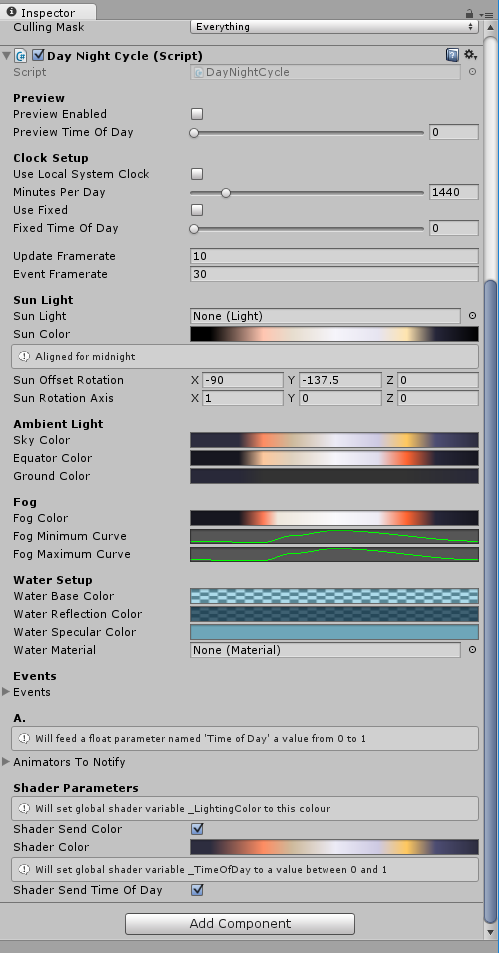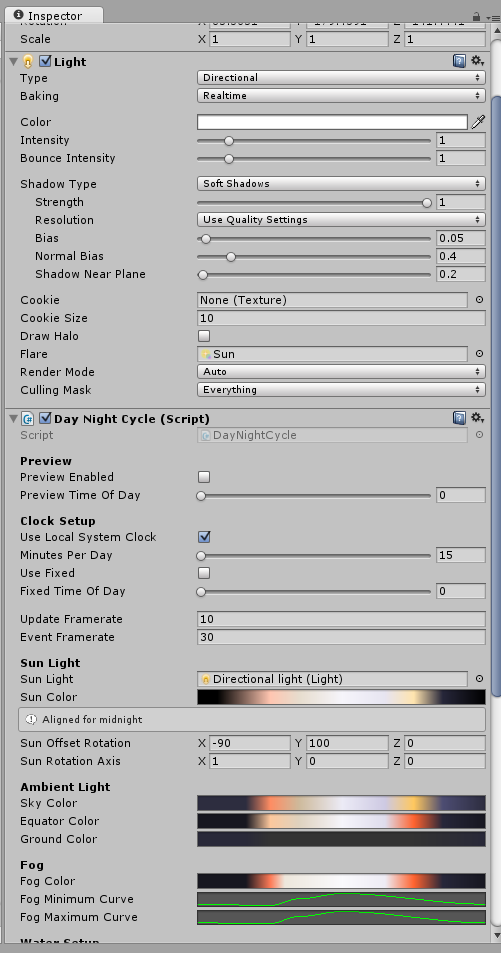| Line 13: | Line 13: | ||
First you will need a directional light to which to attach the script component. A directional light was included when you created a new scene. If one isn't in the hierarchy panel (maybe you deleted it), you'll need to add one. Go to the menus at the top of the editor window and click Game Object - Light - Directional Light. | First you will need a directional light to which to attach the script component. A directional light was included when you created a new scene. If one isn't in the hierarchy panel (maybe you deleted it), you'll need to add one. Go to the menus at the top of the editor window and click Game Object - Light - Directional Light. | ||
| − | You'll need to add the | + | You'll need to add the Day Night Circle component (script) to your directional light. You can create a new empty object to attach with this component. |
| − | + | ||
| − | + | ||
---- | ---- | ||
| Line 27: | Line 25: | ||
|} | |} | ||
---- | ---- | ||
| − | By default, the light will be particularly harsh, the cycle will be set to 1440 minutes (a full 24 hr day) | + | By default, the light will be particularly harsh, the cycle will be set to 1440 minutes (a full 24 hr day), and start from mid night. You can modify the duration as you wish. Toggle the "Use local System Clock" on will use your local timestamp instead of using server time. |
| − | + | If you pick "Use Fixed", the time will be locked, you can set the time you want fix by modify the slider bar of "Fixed Time of Day", the value is from 0 to 1, corresponding the color bar of sun. | |
| − | Toggling the 'Use local System Clock' and 'Shader send time of day' will align your day/night cycle with your real-world local time. I'm uncertain how that will play out if your day length is other than 24 hrs. Finally, if you want to see the sun in the sky, slot the 'Sun' light source type in the 'Flare' slot. | + | Next drag the "Sun light" object into the Sun Light slot, if you create the region by using quick start, then it's the object called "Sun" controls the sun light. |
| + | |||
| + | Toggling the 'Use local System Clock' and 'Shader send time of day' together will align your day/night cycle with your real-world local time. I'm uncertain how that will play out if your day length is other than 24 hrs. Finally, if you want to see the sun in the sky, slot the 'Sun' light source type in the 'Flare' slot. | ||
Selecting some type of shadows and adjusting them will produce that effect. | Selecting some type of shadows and adjusting them will produce that effect. | ||
| + | |||
| + | You can add events like playing music. The events trigger is set to Dawn, Midday, Dusk, and Midnight. | ||
| + | |||
| + | If you have water-like things in your scene, you can attach its material to the water material slot, which can make the light affect to the water too. | ||
There are additional qualities that one can employ to various ends; I'll leave it to the reader to explore and deploy these according to their needs. This should be a great start however, adding 'outdoor' environmental lighting to your scene. | There are additional qualities that one can employ to various ends; I'll leave it to the reader to explore and deploy these according to their needs. This should be a great start however, adding 'outdoor' environmental lighting to your scene. | ||
Level:
Goals:
This wiki entry describes how to set up day and night on your space region using the Day Night Cycle Script component.
First you will need a directional light to which to attach the script component. A directional light was included when you created a new scene. If one isn't in the hierarchy panel (maybe you deleted it), you'll need to add one. Go to the menus at the top of the editor window and click Game Object - Light - Directional Light.
You'll need to add the Day Night Circle component (script) to your directional light. You can create a new empty object to attach with this component.

|
|---|
| Fig. 1: Adding the Day Night Script component to the directional light |
By default, the light will be particularly harsh, the cycle will be set to 1440 minutes (a full 24 hr day), and start from mid night. You can modify the duration as you wish. Toggle the "Use local System Clock" on will use your local timestamp instead of using server time.
If you pick "Use Fixed", the time will be locked, you can set the time you want fix by modify the slider bar of "Fixed Time of Day", the value is from 0 to 1, corresponding the color bar of sun.
Next drag the "Sun light" object into the Sun Light slot, if you create the region by using quick start, then it's the object called "Sun" controls the sun light.
Toggling the 'Use local System Clock' and 'Shader send time of day' together will align your day/night cycle with your real-world local time. I'm uncertain how that will play out if your day length is other than 24 hrs. Finally, if you want to see the sun in the sky, slot the 'Sun' light source type in the 'Flare' slot.
Selecting some type of shadows and adjusting them will produce that effect.
You can add events like playing music. The events trigger is set to Dawn, Midday, Dusk, and Midnight.
If you have water-like things in your scene, you can attach its material to the water material slot, which can make the light affect to the water too.
There are additional qualities that one can employ to various ends; I'll leave it to the reader to explore and deploy these according to their needs. This should be a great start however, adding 'outdoor' environmental lighting to your scene.

|
|---|
| Fig. 2: Directional light details |
A huge thanks and a shout out to Adam Frisby and the Sinewave team for implementing this feature, and to Adam Frisby for walking me through this such that I could get it done right (and make a wiki entry about it ;)
| |||||
| |||||||||||||||||
| ||||||||||||||||||||||||||||||||||||||
| |||||||||||